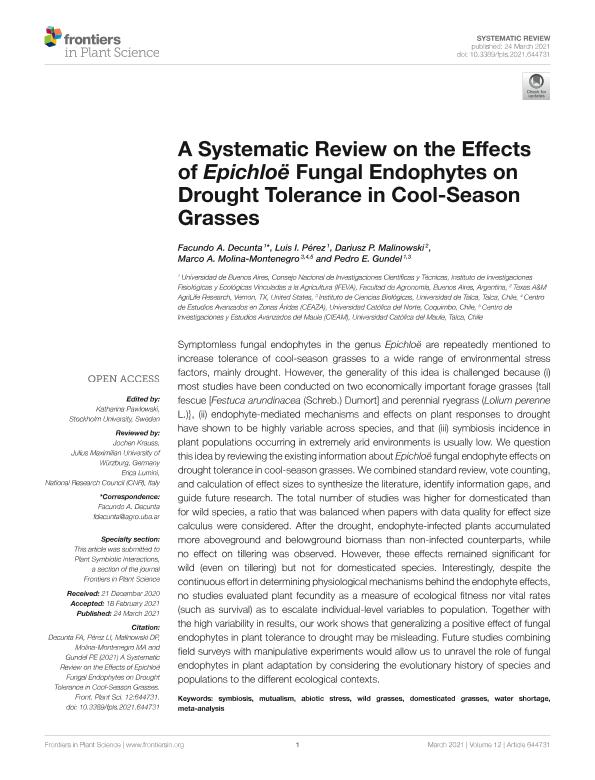Mostrar el registro sencillo del ítem
dc.contributor.author
Dedcunta, Facundo Alcides

dc.contributor.author
Perez, Luis Ignacio

dc.contributor.author
Malinowski, Dariusz P.
dc.contributor.author
Molina Montenegro, Marco A.
dc.contributor.author
Gundel, Pedro Emilio

dc.date.available
2022-09-09T10:38:07Z
dc.date.issued
2021-03
dc.identifier.citation
Dedcunta, Facundo Alcides; Perez, Luis Ignacio; Malinowski, Dariusz P.; Molina Montenegro, Marco A.; Gundel, Pedro Emilio; A Systematic Review on the Effects of Epichloë Fungal Endophytes on Drought Tolerance in Cool-Season Grasses; Frontiers Media; Frontiers in Plant Science; 12; 3-2021; 1-9
dc.identifier.issn
1664-462X
dc.identifier.uri
http://hdl.handle.net/11336/168069
dc.description.abstract
Symptomless fungal endophytes in the genus Epichloë are repeatedly mentioned to increase tolerance of cool-season grasses to a wide range of environmental stress factors, mainly drought. However, the generality of this idea is challenged because (i) most studies have been conducted on two economically important forage grasses {tall fescue [Festuca arundinacea (Schreb.) Dumort] and perennial ryegrass (Lolium perenne L.)}, (ii) endophyte-mediated mechanisms and effects on plant responses to drought have shown to be highly variable across species, and that (iii) symbiosis incidence in plant populations occurring in extremely arid environments is usually low. We question this idea by reviewing the existing information about Epichloë fungal endophyte effects on drought tolerance in cool-season grasses. We combined standard review, vote counting, and calculation of effect sizes to synthesize the literature, identify information gaps, and guide future research. The total number of studies was higher for domesticated than for wild species, a ratio that was balanced when papers with data quality for effect size calculus were considered. After the drought, endophyte-infected plants accumulated more aboveground and belowground biomass than non-infected counterparts, while no effect on tillering was observed. However, these effects remained significant for wild (even on tillering) but not for domesticated species. Interestingly, despite the continuous effort in determining physiological mechanisms behind the endophyte effects, no studies evaluated plant fecundity as a measure of ecological fitness nor vital rates (such as survival) as to escalate individual-level variables to population. Together with the high variability in results, our work shows that generalizing a positive effect of fungal endophytes in plant tolerance to drought may be misleading. Future studies combining field surveys with manipulative experiments would allow us to unravel the role of fungal endophytes in plant adaptation by considering the evolutionary history of species and populations to the different ecological contexts.
dc.format
application/pdf
dc.language.iso
eng
dc.publisher
Frontiers Media

dc.rights
info:eu-repo/semantics/openAccess
dc.rights.uri
https://creativecommons.org/licenses/by-nc-sa/2.5/ar/
dc.subject
ABIOTIC STRESS
dc.subject
DOMESTICATED GRASSES
dc.subject
META-ANALYSIS
dc.subject
MUTUALISM
dc.subject
SYMBIOSIS
dc.subject
WATER SHORTAGE
dc.subject
WILD GRASSES
dc.subject.classification
Ecología

dc.subject.classification
Ciencias Biológicas

dc.subject.classification
CIENCIAS NATURALES Y EXACTAS

dc.title
A Systematic Review on the Effects of Epichloë Fungal Endophytes on Drought Tolerance in Cool-Season Grasses
dc.type
info:eu-repo/semantics/article
dc.type
info:ar-repo/semantics/artículo
dc.type
info:eu-repo/semantics/publishedVersion
dc.date.updated
2022-04-21T16:23:56Z
dc.journal.volume
12
dc.journal.pagination
1-9
dc.journal.pais
Suiza

dc.description.fil
Fil: Dedcunta, Facundo Alcides. Consejo Nacional de Investigaciones Científicas y Técnicas. Oficina de Coordinación Administrativa Parque Centenario. Instituto de Investigaciones Fisiológicas y Ecológicas Vinculadas a la Agricultura. Universidad de Buenos Aires. Facultad de Agronomía. Instituto de Investigaciones Fisiológicas y Ecológicas Vinculadas a la Agricultura; Argentina
dc.description.fil
Fil: Perez, Luis Ignacio. Consejo Nacional de Investigaciones Científicas y Técnicas. Oficina de Coordinación Administrativa Parque Centenario. Instituto de Investigaciones Fisiológicas y Ecológicas Vinculadas a la Agricultura. Universidad de Buenos Aires. Facultad de Agronomía. Instituto de Investigaciones Fisiológicas y Ecológicas Vinculadas a la Agricultura; Argentina
dc.description.fil
Fil: Malinowski, Dariusz P.. Texas A&M University; Estados Unidos
dc.description.fil
Fil: Molina Montenegro, Marco A.. Universidad de Talca; Chile. Universidad Católica del Norte; Chile
dc.description.fil
Fil: Gundel, Pedro Emilio. Consejo Nacional de Investigaciones Científicas y Técnicas. Oficina de Coordinación Administrativa Parque Centenario. Instituto de Investigaciones Fisiológicas y Ecológicas Vinculadas a la Agricultura. Universidad de Buenos Aires. Facultad de Agronomía. Instituto de Investigaciones Fisiológicas y Ecológicas Vinculadas a la Agricultura; Argentina. Universidad de Talca; Chile
dc.journal.title
Frontiers in Plant Science
dc.relation.alternativeid
info:eu-repo/semantics/altIdentifier/url/https://www.frontiersin.org/articles/10.3389/fpls.2021.644731/full
dc.relation.alternativeid
info:eu-repo/semantics/altIdentifier/doi/http://dx.doi.org/10.3389/fpls.2021.644731
Archivos asociados
